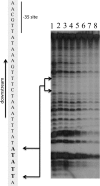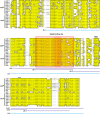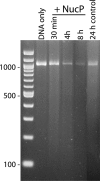Borrelia burgdorferi cp32 BpaB modulates expression of the prophage NucP nuclease and SsbP single-stranded DNA-binding protein
- PMID: 22730122
- PMCID: PMC3415502
- DOI: 10.1128/JB.00661-12
Borrelia burgdorferi cp32 BpaB modulates expression of the prophage NucP nuclease and SsbP single-stranded DNA-binding protein
Erratum in
-
Correction for Chenail et al., "Borrelia burgdorferi cp32 BpaB Modulates Expression of the Prophage NucP Nuclease and SsbP Single-Stranded DNA-Binding Protein".J Bacteriol. 2017 Sep 5;199(19):e00400-17. doi: 10.1128/JB.00400-17. Print 2017 Oct 1. J Bacteriol. 2017. PMID: 28874457 Free PMC article. No abstract available.
Abstract
The Borrelia burgdorferi BpaB proteins of the spirochete's ubiquitous cp32 prophages are DNA-binding proteins, required both for maintenance of the bacteriophage episomes and for transcriptional regulation of the cp32 erp operons. Through use of DNase I footprinting, we demonstrate that BpaB binds the erp operator initially at the sequence 5'-TTATA-3'. Electrophoretic mobility shift assays indicated that BpaB also binds with high affinity to sites located in the 5' noncoding regions of two additional cp32 genes. Characterization of the proteins encoded by those genes indicated that they are a single-stranded DNA-binding protein and a nuclease, which we named SsbP and NucP, respectively. Chromatin immunoprecipitation indicated that BpaB binds erp, ssbP, and nucP in live B. burgdorferi. A mutant bacterium that overexpressed BpaB produced significantly higher levels of ssbP and nucP transcript than did the wild-type parent.
Figures








Similar articles
-
BpaB, a novel protein encoded by the Lyme disease spirochete's cp32 prophages, binds to erp Operator 2 DNA.Nucleic Acids Res. 2010 Sep;38(16):5443-55. doi: 10.1093/nar/gkq284. Epub 2010 Apr 26. Nucleic Acids Res. 2010. PMID: 20421207 Free PMC article.
-
Borrelia burgdorferi EbfC, a novel, chromosomally encoded protein, binds specific DNA sequences adjacent to erp loci on the spirochete's resident cp32 prophages.J Bacteriol. 2006 Jun;188(12):4331-9. doi: 10.1128/JB.00005-06. J Bacteriol. 2006. PMID: 16740939 Free PMC article.
-
BpaB and EbfC DNA-binding proteins regulate production of the Lyme disease spirochete's infection-associated Erp surface proteins.J Bacteriol. 2012 Feb;194(4):778-86. doi: 10.1128/JB.06394-11. Epub 2011 Dec 9. J Bacteriol. 2012. PMID: 22155777 Free PMC article.
-
Correction for Chenail et al., "Borrelia burgdorferi cp32 BpaB Modulates Expression of the Prophage NucP Nuclease and SsbP Single-Stranded DNA-Binding Protein".J Bacteriol. 2017 Sep 5;199(19):e00400-17. doi: 10.1128/JB.00400-17. Print 2017 Oct 1. J Bacteriol. 2017. PMID: 28874457 Free PMC article. No abstract available.
-
Erp and Rev Adhesins of the Lyme Disease Spirochete's Ubiquitous cp32 Prophages Assist the Bacterium during Vertebrate Infection.Infect Immun. 2023 Mar 15;91(3):e0025022. doi: 10.1128/iai.00250-22. Epub 2023 Feb 28. Infect Immun. 2023. PMID: 36853019 Free PMC article. Review.
Cited by
-
Distribution of cp32 prophages among Lyme disease-causing spirochetes and natural diversity of their lipoprotein-encoding erp loci.Appl Environ Microbiol. 2013 Jul;79(13):4115-28. doi: 10.1128/AEM.00817-13. Epub 2013 Apr 26. Appl Environ Microbiol. 2013. PMID: 23624478 Free PMC article.
-
Changes in bacterial growth rate govern expression of the Borrelia burgdorferi OspC and Erp infection-associated surface proteins.J Bacteriol. 2013 Feb;195(4):757-64. doi: 10.1128/JB.01956-12. Epub 2012 Dec 7. J Bacteriol. 2013. PMID: 23222718 Free PMC article.
-
Epigenomic Landscape of Lyme Disease Spirochetes Reveals Novel Motifs.mBio. 2021 Jun 29;12(3):e0128821. doi: 10.1128/mBio.01288-21. Epub 2021 Jun 22. mBio. 2021. PMID: 34156261 Free PMC article.
-
Lost in plasmids: next generation sequencing and the complex genome of the tick-borne pathogen Borrelia burgdorferi.BMC Genomics. 2017 May 30;18(1):422. doi: 10.1186/s12864-017-3804-5. BMC Genomics. 2017. PMID: 28558786 Free PMC article.
-
Biochemical characterization of Borrelia burgdorferi's RecA protein.PLoS One. 2017 Oct 31;12(10):e0187382. doi: 10.1371/journal.pone.0187382. eCollection 2017. PLoS One. 2017. PMID: 29088268 Free PMC article.
References
-
- Alitalo A, et al. 2002. Complement inhibitor factor H binding to Lyme disease spirochetes is mediated by inducible expression of multiple plasmid-encoded outer surface protein E paralogs. J. Immunol. 169:3847–3853 - PubMed
-
- Beaurepaire C, Chaconas G. 2005. Mapping of essential replication functions of the linear plasmid lp17 of B. burgdorferi by targeted deletion walking. Mol. Microbiol. 57:132–142 - PubMed
Publication types
MeSH terms
Substances
Grants and funding
LinkOut - more resources
Full Text Sources
Miscellaneous

